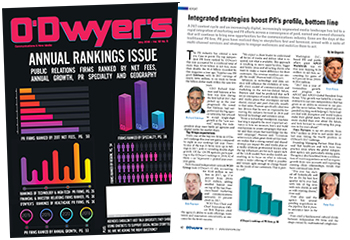 Michael Roth |
When articles began popping up about “purpose-driven companies” years back, I must admit that I found the concept kind of odd.
Having worked in life sciences for more than two decades in therapeutic areas like ALS, Parkinson’s, Depression, Gaucher’s Disease and Oncology, it was clear that the “purpose” of our clients’ work was improving and saving people’s lives. Similarly, the “purpose” of healthcare communications was to help people understand the value of these medical breakthroughs that impact them or their family members and help as many people gain access to the product or device as possible. We were under no illusion that profit — and sometimes, greed — played a big role in the industry, but above all of this was a greater “purpose.”
For this reason, many people in healthcare communications tend to cast a jaundiced eye at other industries: consumer goods, banking, travel. In our collective minds, their only “purpose” is to make money. The truth is, many other industries have a noble and purpose-driven heritage.
|
|
Let’s take two high profile American insurance companies as examples. MetLife’s “purpose” is to provide a financial safety net for American families that are looking to protect all that they have built in their lives. MetLife began its journey in 1863 when a group of New York City businessmen raised $100,000 to found the National Union Life and Limb Insurance Company. The company insured Civil War sailors and soldiers against disabilities due to wartime wounds, accidents, and sickness. In anyone’s mind, a truly noble purpose. In 1868, the Company changed its name to Metropolitan Life Insurance Company and shifted its focus to the life insurance business. While the Company evolved, the purpose remained: to serve the community with real individual impact.
Similarly, Aetna had a purpose-driven heritage: to help victims of fires recover from devastation that seemed to be epidemic in American cities in the 1800s. Aetna was known for many years as Aetna Fire Insurance Company. While their business model has evolved quite a bit over time, a steadfast dedication to purpose and impact upon the community that they served was never an issue. In recent years, Aetna has evolved from a health insurance company to a healthcare company, focusing on its members’ wellness (versus sickness), their personalized health ambitions, social determinants of health and the importance of localization of healthcare. They have become an ideal example of a purpose-driven company.
What is a real purpose-driven company?
There are, of course, numerous companies in other industries that share a purpose-driven heritage: industries like travel, utilities, transportation, professional services and even banking. But heritage is not a prerequisite for building a purpose-driven company. Many companies in the modern age are trying to figure out exactly where they fit into this not-so-new, conceptual paradigm. How can they be purpose-driven, and if it’s not about corporate heritage or even product or service output, what exactly is a purpose-driven company?
While there’s no definitive definition, it’s clear that “purpose-driven” companies of all kinds are born out of one simple idea: it is the obligation of every business (and every person) to improve the world in even the smallest way.
A purpose-driven business need not be totally selfless or philanthropic, but you must identify a genuine need within society (e.g., psychological, emotional, physical) and work hard to fill that need. Your work must have a positive impact on the communities that you serve including direct targets, employees and non-customers.
The rationale for becoming a purpose-driven business is also simple. When there’s a real emotional connection to a brand, there’s more trust between the customer, community and the company. And this relationship is more conducive to a fruitful business relationship. It makes common sense.
Purpose-driven doesn’t mean perfect
One would think that a company’s allegiance to positively impacting society would make it easier to map out its narrative, messaging, content, thought leadership and social media. Not so fast. There’s still the age-old nemesis of advocacy-based communications, which is the reality of the situation. Persuading the public that they need sneakers because it will help fix the dearth of inner city jobs, or that they need a five-dollar cup of coffee because fair trade and the rain forest is critical to us all, is a tough sell. There must be real connective utility, substance and transparency behind the brand promise, vision and “purpose.” Consumers must feel and see the impact.
Sometimes there are activities or incidents that fall outside of the company “purpose,” or even fly in the face of that purpose: the death of a patient because a health insurance claim was rejected, or a pill didn’t work right, or an exploding product that creates institutional mistrust. Even purpose-driven businesses are subject to failure because of human or other mistakes, in spite of a company’s best intentions.
Proving purpose after a setback
The biggest setback — and potential turnaround — that I’ve seen in recent years to a brand purpose started on April 12 in a Pennsylvania Starbucks. Two black men were wrongfully arrested in a racially-biased incident. Starbuck’s purpose is to inspire and nurture the human spirit: one person, one cup, one neighborhood at a time. And this incident directly contradicted that purpose.
Starbucks’ CEO acted immediately to make certain that their purpose was not compromised. In addition to firing the manager that used poor judgement and had the men arrested, their CEO met with the two men to apologize directly to them for the harm that his company has caused them and the community. Starbucks announced that it will close all its coffee shops on May 29 to provide racial bias training to nearly 175,000 employees. The training — aimed at preventing discrimination at Starbucks shops — comes in response to swift public outcry and the company’s commitment to accountability and change.
Interviews with Starbucks’ CEO after the meeting with the two men wrongfully arrested demonstrated his authentic distress and regret. Starbucks is vested in the community, and they will now work hard to make sure that racial discrimination is never tolerated in its stores or communities. We’ll see what happens in the coming months, but the corporate response of strong words, combined with clear action, seemed to be elevated by its institutional belief in its purpose.
Working with purpose-driven companies
Following are five tips to help map out an integrated communications campaign to further a purpose-driven client’s business objectives and enhance and protect its corporate reputation.
Executives exposed to media must be authentic, believable and transparent. The death knell of any purpose-driven corporation are people that don’t carry the brand purpose with them during interviews, regardless of the audience. Similarly, employees that appear to be oblivious to their brand promise can hurt the reputation of the entire company.
Corporate narrative and messaging must be tied to the purpose. Top down: demonstrate with words and actions how you’re fulfilling your purpose.
Have the courage to tell your client when they’re “off purpose.”
Leverage your target audiences: the beneficiaries of your purpose-driven work. If there is a true positive impact, your customers should want to speak about it. Leverage their words and personification of your purpose. SHOW how you impact the community.
Don’t be afraid to acknowledge other purpose-driven companies. You’re part of a community. The old idea of competition isn’t all that appealing to the next -generation. Companies are less like a football game than a giant music festival. There are no enemies, just different companies playing in different places. Wish everyone well.
***
Michael Roth is a Bliss Integrated Communication partner and head of its healthcare practice.



 Lo Isidro, senior director at Real Chemistry with more than a decade of strategic communications and PA experience, has joined Narrative Strategies.
Lo Isidro, senior director at Real Chemistry with more than a decade of strategic communications and PA experience, has joined Narrative Strategies. Nelson Fernandez, former North American chair of APCO Worldwide and managing director of Burson-Marsteller, has joined Volunteers in Medicine Berkshires as director of communications and PA.
Nelson Fernandez, former North American chair of APCO Worldwide and managing director of Burson-Marsteller, has joined Volunteers in Medicine Berkshires as director of communications and PA. Lilit Bargar, who was most recently an EVP in the healthcare practice at Weber Shandwick, comes on board at GCI Health as EVP, corporate practice lead.
Lilit Bargar, who was most recently an EVP in the healthcare practice at Weber Shandwick, comes on board at GCI Health as EVP, corporate practice lead.
 Five ways that successful thought leaders are made.
Five ways that successful thought leaders are made.


 Have a comment? Send it to
Have a comment? Send it to 
No comments have been submitted for this story yet.